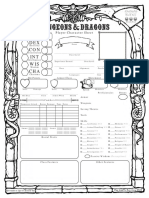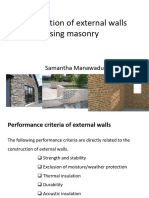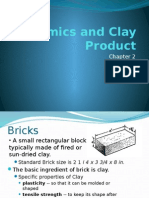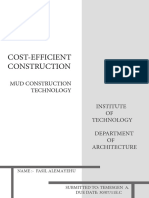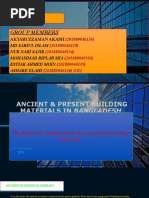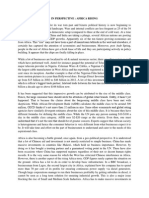Walled House
Walled House
Uploaded by
Priyanka RajaniCopyright:
Available Formats
Walled House
Walled House
Uploaded by
Priyanka RajaniCopyright
Available Formats
Share this document
Did you find this document useful?
Is this content inappropriate?
Copyright:
Available Formats
Walled House
Walled House
Uploaded by
Priyanka RajaniCopyright:
Available Formats
Vault Roof and Mud-walled House
Problem/Need The depletion of building resources like timber, bamboo and thatch have progressively made the village house-builders jobs more and more difficult. Timber used to be the principal structural material while bamboo came in handy for almost everything. Shrinking forests have contributed to removing timber and bamboo from the reach of the poor. Even thatch has become scarce and the frequent repair require for thatch roofs make them problematic. Local mud fortresses or garhis furnished excellent building mud. These garhis are getting extinct and the resource drying out. Black cotton soil is unfit for wall making. The need therefore is to have a roof timber or thatch along with mud walls using ordinarily available soil. Approach/Strategy The above need was sought to be met through designing a low-cost house with an arched roof of hollow cylindrical clay tiles resting on a ring beam supported by brick pillars, while the nonsupporting walls are made from non-erodible and rodent-proof mud walls using special techniques. This technique has been developed and propagated by Centre of Science for Villages (Wardha). Technology Package Guna Vault Roof: Guna in Telugu, is a tapering, burnt clay pipe. The familiar semi-cylindrical pan tiles are obtained by splitting such pipes vertically into two. These Guna tapering pipes can be socketed into one another forming an arch over a suitably curved shuttering. A series of such arches make a barrel vault capable of withstanding considerable loads upto 1 ton/m2. The top of the roof is given a plaster finish. After joints are filled and topped with plaster, the roof becomes rigid and waterproof, doing totally without steel or timber. The cost of this roof works out to Rs. 20/sq.ft. It has the following advantages: Air inside the hollow-tiled roof protects from heat and cold. A 10o temperature difference is observed in slab roof and guna vault roof. It has no under structure, yet can bear weight of 1000 kg/m2. It is fabricated and ready for use within 3 days. Requires no maintenance and has life span of more than 50 years. It is not affected by rain, hail or wind. Being light in weight (less than 12 kg/sq.ft). the vault roof is safe even in earthquakes. Even if the mud walls collapse, the roof remains intact residing on pillars and beams.
After construction of brick pillars, ring beams and gable walls, the M.S. trusses are placed in position above the opposite pillars held with guy ropes and timber poles. Now GI pipes (12 mm dia., 10 nos.) are placed on the trusses in the MS rings provided at specific points. They are supported by gable walls at both ends. Guna pipes are now laid dry on this skeleton shuttering in a plug-socket manner, completing the roof ring by ring. Lime/cement mortar is now poured on the roof, trowelling it into the gaps and leaving the top rough to receive the finishing coat. Care is taken to remove the skeleton support within 12 hours to allow natural setting. Tile-faced Mud Blocks: Several combinations of the locally available Black Cotton (BC) soil, which has good binding properties, with bhaswa and murram (hard soil) are possible for making adobe blocks. One part of BC soil to four parts of murram makes strong blocks with reasonable stability through moisture cycles. However, the exterior face of a mud wall succumbs to
weathering and consequent erosion necessitating maintenance cycles beyond the time resources of poor daily-wage labourers. This enforced neglect is commonly noticed in dilapidated walls. CSVs Wardha Blocks have combined the low cost of mud with weather resistance of terra cotta. One face of the block is provided with a weatherproof skin, a bunt clay tile with a dovetail key at the back to anchor it to the block. Red clay pottery continues to be a traditional skill in the region. These tiles draw on these skills and resources, for this new product. The tiles are made with simple techniques using wooden moulds. The face tiles measures 9 x 4 x and has a key 1 key projection. Householders can also make it. One woman can make 250 such tiles a day, which can then be baked locally by the village potter. Each face tile costs 40 p. or less. Moulding the Mud Block: Standard block size adopted at CSV is 225/300 x 100 x 225 mm (9/10 x 4 x 9) taking into account ease of handling. One may use wooden or steel moulds, as available. A pair of workers usually produces 200-225 blocks per day. The facing tile is placed in the mould box with its face side touching the mould wall. Mud mortar (1 part BC soil to 4 parts murram) is poured at the back, working it well around the dovetail key. Rain-proof & Rodent-proof Mud wall: With no need for a press or a ram or cement, the tile faced blocks are put out together to form walls that look and feel like pucca brick walls and do not allow water or rats to enter. In BC soil, 9 x 9 brick pillars support the roof usually at 5 ft. intervals. If required the inner surface of the wall can also be tiled to a height of 2-3 ft. Rain Beam: The sideways thrust of the vault roof requires to be overcome by a ring beam of 3 thickness. This is reinforced by three 8 mm bars. Extending and adding 1 ft. around the house, the total steel used for a 250 sq. ft. house is less than 50 kg. CSV has integrated these features into a twin house design and built a few hundred house dispersed in several locations in the district. At 1993 prices each house costs approximately Rs. 8500. System Design Given the raw materials, i.e. the guna roof tiles, wall tiles, bricks, cement and miscellaneous building materials as indicated above a team trained in these techniques can undertake construction of twenty houses (ten twin houses) in a month and a half. Local artisans and labour will be utilized. In each district 10 such teams can work simultaneously. To maintain a supply of tiles, 15 potters will be engaged all the year round. The techniques being simple for traditional artisans to learn, on-job training of masons and potters can be done in a short period. 2 masons and 1 potter may be trained at CSV for 3 months and they should subsequently train others. Economics (Low-cost houses for landless labour under RLEGP/JRY) Description Quantity Rate Excavation for foundation 126 cft. 68.00/100 cft. Foundation, uncrossed rubble masonry 160 cft. 19.20/cft. Brick pillars 34 cft. 30.00 Wall of tile faced sun dried mud blocks 150 cft. 13.50 Ring beam 10.31 135.00 Gable wall 60 cft. 13.55 Guna vault roofing 201.25 25.50 Ordinary wood doors 2 nos 275.00 Window with grills 3 nos 35.00 Flooring Lumpsum Total Amt. (Rs.) 85.68 3,072.00 1,020.00 2,025.00 1,391.85 813.00 5,131.88 550.00 105.00 180.00 14,374.41
Helpline: Centre of Science for Villages (CSV) Magan Sanghralaya Wardha, Maharashtra - 442 001 Ph: - 07152-2562 Fax: 07152-2111
You might also like
- Erdman Hall DormitoriesDocument26 pagesErdman Hall DormitoriesQuratul Ain MalickNo ratings yet
- Answer Key To World English 3 Workbook Reading and Crossword Puzzle ExercisesDocument3 pagesAnswer Key To World English 3 Workbook Reading and Crossword Puzzle Exercisesjuanma2014369% (13)
- Topic 3 Brick & MasonryDocument36 pagesTopic 3 Brick & MasonryO. L. K. (On)No ratings yet
- Types of Mud Wall ConstructionDocument23 pagesTypes of Mud Wall ConstructionJency Kuruvilla71% (14)
- Old School 5E D&D Character Sheet (Form) - 1Document2 pagesOld School 5E D&D Character Sheet (Form) - 1bigkev73No ratings yet
- Common and Proper Nouns Reading Level 02Document4 pagesCommon and Proper Nouns Reading Level 02Nikki BaekNo ratings yet
- Adobe & Bamboo TechniqDocument43 pagesAdobe & Bamboo TechniqMilliee Brar100% (3)
- Concrete Blocks NotesDocument16 pagesConcrete Blocks NotesDharshan KNo ratings yet
- Rammed Earth Construction PDFDocument33 pagesRammed Earth Construction PDFAr Nizya Noushad100% (3)
- Straw Bale ConstructionDocument23 pagesStraw Bale Constructionjoshjeth67% (3)
- Attica AlcmaeonidDocument5 pagesAttica AlcmaeonidGRMARMATAKISNo ratings yet
- Czech Castles and ChateauxDocument52 pagesCzech Castles and ChateauxDauntless Jaunter Travel SiteNo ratings yet
- Low Cost House (Wardha Pattern) : Sandeep KulkarniDocument3 pagesLow Cost House (Wardha Pattern) : Sandeep Kulkarnishamali pohankarNo ratings yet
- Materials and TechniquesDocument48 pagesMaterials and Techniquesfile cr100% (1)
- Rammed Earth - Module3Document24 pagesRammed Earth - Module3Aditi Sharma100% (1)
- Earth Construction TechniquesDocument22 pagesEarth Construction TechniquesPraveen Sharma100% (1)
- Alternative Technologies in Building ConstructionDocument24 pagesAlternative Technologies in Building ConstructionMuskan ChoudharyNo ratings yet
- Construction TechniquesDocument8 pagesConstruction Techniquesarshi_raushan3427No ratings yet
- Terracotta: Characteristics of Terra CottaDocument15 pagesTerracotta: Characteristics of Terra CottaAswajith K BabuNo ratings yet
- 4 Durability and Service Life of Mud HousesDocument8 pages4 Durability and Service Life of Mud Housesmarc chucuenNo ratings yet
- Himani Goyal Second Year, B Roll No:17 Vastu Kala Academy of ArchitectureDocument27 pagesHimani Goyal Second Year, B Roll No:17 Vastu Kala Academy of Architecturelokranjan100% (2)
- Earth - BambooDocument12 pagesEarth - BambooPrerana CholakheNo ratings yet
- Module 2Document8 pagesModule 2rox905103No ratings yet
- Low Cost Construction TechniquesDocument20 pagesLow Cost Construction TechniquesJai Belpathak Shejwalkar100% (3)
- Housing Module 4Document11 pagesHousing Module 4Kyla TiangcoNo ratings yet
- Vernacular Architecture in KashmirDocument6 pagesVernacular Architecture in KashmirGUNJAN33% (3)
- Bamboo Crete HouseDocument2 pagesBamboo Crete HouseChandan Bose100% (1)
- 34.traditional Earth Construction and GlazingDocument9 pages34.traditional Earth Construction and GlazingmariyaNo ratings yet
- Masonry Concrete StructureDocument194 pagesMasonry Concrete Structureshruthi SundaramNo ratings yet
- Rice Straw Bale Construction in Modern ArchitectureDocument36 pagesRice Straw Bale Construction in Modern ArchitectureTmt TarekNo ratings yet
- Unit 8 - Construction of External Walls Using MasonryDocument71 pagesUnit 8 - Construction of External Walls Using MasonryDhanusha RukshanNo ratings yet
- Bricks Notes For AL Tech by Hafeel SirDocument84 pagesBricks Notes For AL Tech by Hafeel SirIhthisam hamzaNo ratings yet
- On Strawble ConstructionsDocument17 pagesOn Strawble ConstructionsNanditha Mandava ChowdaryNo ratings yet
- Unfired Clay Masonry: Information Paper IP 16/11Document6 pagesUnfired Clay Masonry: Information Paper IP 16/11Amanpreet singhNo ratings yet
- ElectiveDocument12 pagesElectiveayoushika abrolNo ratings yet
- Ceramics and Clay ProductDocument17 pagesCeramics and Clay ProductKarmela HirondoNo ratings yet
- VERNACULAR ARCHITECTURE (Mud)Document26 pagesVERNACULAR ARCHITECTURE (Mud)Ashina Gupta100% (1)
- Adobe - Construction - V1Document12 pagesAdobe - Construction - V1lokiyo1965No ratings yet
- Masonry Structures LectureDocument10 pagesMasonry Structures LecturemikramNo ratings yet
- Const. Techniques ReportDocument2 pagesConst. Techniques ReportUday AaronNo ratings yet
- Rural Architecture of KashmireDocument10 pagesRural Architecture of KashmireNeha HegdeNo ratings yet
- ADOBEDocument123 pagesADOBEMohit ArchitectsNo ratings yet
- Clay and Ceramic ProductsDocument15 pagesClay and Ceramic Productsanurag.chakrani456No ratings yet
- Ar Bricks-21Document34 pagesAr Bricks-21ManishaChary100% (1)
- Costford Technology PDFDocument44 pagesCostford Technology PDFsahilaneja91No ratings yet
- Properties and Use of Construction MaterialsDocument13 pagesProperties and Use of Construction Materialsjake masonNo ratings yet
- Mud Construction TechnologyDocument14 pagesMud Construction TechnologyTESFA SILNo ratings yet
- Group Members: White StoneDocument38 pagesGroup Members: White StoneAshiqNo ratings yet
- Low Cost HousingDocument48 pagesLow Cost HousingManish Solanki71% (7)
- Lecture 4Document18 pagesLecture 4Awwal EdrisNo ratings yet
- Why Build With Straw BalesDocument21 pagesWhy Build With Straw BalesjarlinsujiNo ratings yet
- Exterior Finishes: Jaspreet Kaur Aulakh B.Arch 2nd Year 4th Semester K.R.Mangalam S.A.PDocument29 pagesExterior Finishes: Jaspreet Kaur Aulakh B.Arch 2nd Year 4th Semester K.R.Mangalam S.A.PJaspreet AulakhNo ratings yet
- Module - 4 Altenative Building Technologies Efficient FoundationsDocument54 pagesModule - 4 Altenative Building Technologies Efficient FoundationsVishal NaikNo ratings yet
- Low Cost Building Material and Techniques - Harshika - ParikshitDocument22 pagesLow Cost Building Material and Techniques - Harshika - ParikshitVinit ShahNo ratings yet
- Abt Unit IIIDocument36 pagesAbt Unit IIIkridabbossNo ratings yet
- Funicular Shells Part-1Document2 pagesFunicular Shells Part-1yadavshemant0% (1)
- Rattrap BondDocument5 pagesRattrap Bond12chamchaNo ratings yet
- Mud As A FinishDocument18 pagesMud As A FinishMITI DOSHINo ratings yet
- Straw Bale ConstructionDocument23 pagesStraw Bale ConstructionMladen Mohr0% (1)
- Kle Institute of Technology, Hubli: Team MembersDocument12 pagesKle Institute of Technology, Hubli: Team MembersVijayanand PrajwalNo ratings yet
- Chimneys, Gables and Gargoyles: A Guide to Britain's RooftopsFrom EverandChimneys, Gables and Gargoyles: A Guide to Britain's RooftopsRating: 5 out of 5 stars5/5 (1)
- Fresco Painting - Modern Methods and Techniques for Painting in Fresco and SeccoFrom EverandFresco Painting - Modern Methods and Techniques for Painting in Fresco and SeccoNo ratings yet
- Heritage ConservationDocument86 pagesHeritage ConservationPriyanka Rajani100% (1)
- Doodle Art TIPS PDFDocument22 pagesDoodle Art TIPS PDFPriyanka Rajani100% (4)
- Intach Conservation Institutes (Ici) Examination: Boat-Building Diorama at Odisha State Maritime Museum, CuttackDocument2 pagesIntach Conservation Institutes (Ici) Examination: Boat-Building Diorama at Odisha State Maritime Museum, CuttackPriyanka RajaniNo ratings yet
- Role of ToursmDocument8 pagesRole of ToursmPriyanka RajaniNo ratings yet
- Africa Rising (1)Document2 pagesAfrica Rising (1)Priyanka RajaniNo ratings yet
- 8 Management Lessons From Dhoni For UPADocument3 pages8 Management Lessons From Dhoni For UPAPriyanka RajaniNo ratings yet
- Calculating Heat Loss or GainDocument3 pagesCalculating Heat Loss or GainPriyanka RajaniNo ratings yet
- 05 Guidelines Publicrealm 2007Document20 pages05 Guidelines Publicrealm 2007Priyanka RajaniNo ratings yet
- Architectural Blossoming of The LotusDocument28 pagesArchitectural Blossoming of The LotusPriyanka RajaniNo ratings yet
- Barrier Free Architecture, Nagpur Railway StationDocument17 pagesBarrier Free Architecture, Nagpur Railway StationPriyanka Rajani75% (8)
- South African Tropical ModernismDocument5 pagesSouth African Tropical ModernismJuliet BenningNo ratings yet
- (Type The Document Title) : Ekalavya Model Residential SchoolDocument2 pages(Type The Document Title) : Ekalavya Model Residential SchoolSatyapriya PangiNo ratings yet
- As BuiltDocument8 pagesAs BuiltArfanAliNo ratings yet
- Tints and Shades Lesson PlanDocument5 pagesTints and Shades Lesson PlanJane_Clowser50% (4)
- Epoxy HandbookDocument80 pagesEpoxy HandbookJayesh2281100% (2)
- Detail July-August 2017Document108 pagesDetail July-August 2017Sofos93100% (5)
- Blackout PoetryDocument12 pagesBlackout PoetryCabbagesAndKingsMagNo ratings yet
- I CAN Statement Tracker: Self PortraitsDocument2 pagesI CAN Statement Tracker: Self Portraitsapi-270646532No ratings yet
- 8 Steps New Concept CarDocument10 pages8 Steps New Concept CarHarold BonillaNo ratings yet
- Paints and CoatingsDocument22 pagesPaints and CoatingsFatima LiaquatNo ratings yet
- Build 138 24 Build Right Concrete Slabs and Control JointsDocument3 pagesBuild 138 24 Build Right Concrete Slabs and Control Jointssuejack2020No ratings yet
- Arts 7 Quarter 3 SLM 1Document5 pagesArts 7 Quarter 3 SLM 1Caryll BaylonNo ratings yet
- PDFDocument6 pagesPDFLavinia GeorgianaNo ratings yet
- UD135 MagazineDocument52 pagesUD135 MagazineFrizky TifandraNo ratings yet
- CPAR Reviewer EditedDocument16 pagesCPAR Reviewer EditedSTO. DOMINGO, Aneka MaghintayNo ratings yet
- World's Fair: Newsletters 8Document118 pagesWorld's Fair: Newsletters 8JohnWilliams86No ratings yet
- The Colour of ChelseaDocument8 pagesThe Colour of ChelseaPatrick BatyNo ratings yet
- DTP: Using Pagemaker Producing Professional DTP Destined For Commercial PrintDocument33 pagesDTP: Using Pagemaker Producing Professional DTP Destined For Commercial PrintKingsley MNo ratings yet
- Art and Psychology Essay 3rd DraftDocument10 pagesArt and Psychology Essay 3rd Draftapi-407108099No ratings yet
- Burns Quattrocento Architecture and The AntiqueDocument16 pagesBurns Quattrocento Architecture and The AntiqueCharline TetiyevskyNo ratings yet
- Redwedgebroc 1Document2 pagesRedwedgebroc 1api-223870209No ratings yet
- 3D-World Christmas-2013 Preview PDFDocument10 pages3D-World Christmas-2013 Preview PDFCarlos Vladimir Roa Luna0% (1)
- Museum PaperDocument5 pagesMuseum Papernhel armstrongNo ratings yet
- The Landlady Roald DahlDocument29 pagesThe Landlady Roald Dahlmusicalstar1100% (1)




